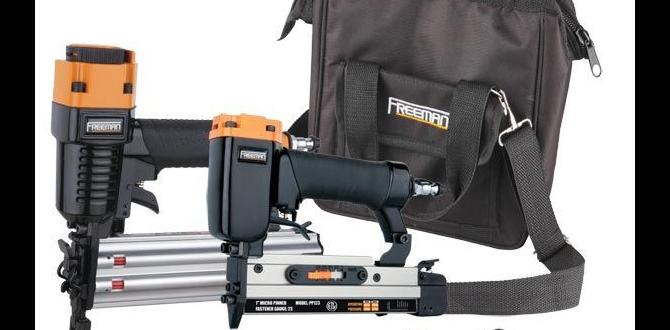The right nail length for your framing nailer makes all the difference in creating strong, secure structures. This comprehensive guide helps beginners select the perfect nail size for any framing job, ensuring your projects are built to last.
When you’re diving into a framing project, picking the right nail length for your framing nailer can feel like a puzzle. It’s a common hang-up for beginners, and for good reason! Using nails that are too short means a weak connection, while nails that are too long can cause problems like damaging materials or even poking through where you don’t want them. Don’t worry, though! With a little understanding, you’ll be choosing nail lengths like a pro in no time. We’re going to break down exactly what you need to know, step-by-step, so you can build with confidence. Let’s get started and make sure your projects are as solid as they can be!
Table of Contents
Why Nail Length Matters in Framing
Choosing the correct nail length for your framing projects is far more than just picking a number. It’s the foundation of structural integrity. A nail that’s too short simply won’t penetrate deeply enough into the lumber to create a strong, reliable bond. Think of it like trying to hold two pieces of wood together with a wimpy handshake – it just won’t hold under stress. On the flip side, a nail that’s excessively long can be a nuisance and a hazard. It might split the wood, especially near the ends, compromise the look of your project by protruding, or even create a safety risk if it pokes through unexpectedly. The goal is always a secure hold that grips both pieces of wood effectively, providing lasting stability without causing unnecessary damage.
Understanding Framing Lumber and Nail Penetration
Before we talk nails, let’s quickly chat about the wood you’ll be working with. Common framing lumber, like 2x4s and 2x6s, are typically made from softwood species such as pine, spruce, or fir. These woods are generally strong enough for structural purposes but are also forgiving enough to accept nails without excessive splitting. The “2x” designation (e.g., 2×4) actually refers to the nominal size of the lumber, not its exact dimensions. A standard 2×4 is actually 1.5 inches thick by 3.5 inches wide. Understanding these real dimensions is key to calculating nail penetration.
When you drive a nail, you want it to go through the first piece of wood and embed itself securely into the second piece. The general rule of thumb for good adhesion and structural strength is that the nail should penetrate at least 1 to 1.5 inches into the second piece of wood. This depth ensures that the nail has enough surface area in contact with both pieces of lumber to create a robust connection that resists pulling apart. This is crucial for load-bearing walls, roof Rafters, and floor joists, where failure is simply not an option.
For more detailed information on lumber grading and dimensions, resources like the Woodworking Network offer great insights into the materials we commonly use.
The Different Types of Framing Nails
Framing nails aren’t all created equal. They come in various lengths, diameters, and head styles, each designed for specific applications. For framing nailers, we’re typically talking about two main types of nails:
Common Nails: These are robust nails with a larger head diameter. The wide head provides a good surface area to prevent the nail from pulling through the wood. They are a staple in many construction and framing tasks.
Clipped Head Nails: These nails have a portion of their heads removed. This design allows more nails to fit into a strip, meaning your nailer can hold more nails before needing a reload, which speeds up work. However, clipped head nails may not offer the same holding power as a full round head nail due to the reduced head surface area. They are often used in applications where structural load isn’t the absolute highest priority or where speed is paramount.
The diameter of the nail (often referred to by its “gauge”) also plays a role in holding power. Thicker nails generally offer greater strength but can also be more prone to splitting the wood if not used carefully. Framing nailer nails are typically in the 0.113 to 0.162 inch diameter range.
How to Choose the Right Nail Length: A Step-by-Step Guide
Let’s get down to business! Choosing the correct nail length involves a bit of simple math and understanding the materials you’re fastening.
Step 1: Measure the Thickness of Your Lumber
First, identify the nominal size of the lumber you are framing with (e.g., 2×4, 2×6). Then, determine its actual thickness. Most standard dimensional lumber has a thickness defined as:
2x Lumber (e.g., 2×4, 2×6, 2×8, 2×10, 2×12): Actual thickness is 1.5 inches.
4x Lumber (e.g., 4×4): Actual thickness is 3.5 inches.
For common framing applications using 2x lumber, you’ll almost always be dealing with the 1.5-inch thickness.
Step 2: Determine Desired Penetration
As mentioned, you want your nail to penetrate at least 1 to 1.5 inches into the second piece of wood. For maximum structural strength, aiming for the higher end of this range (1.5 inches) is often preferred.
Let’s create a simple table to visualize this:
| Application | Lumber Thickness (Actual) | Desired Penetration into Second Piece | Target Nail Length |
|---|---|---|---|
| Joining two 2x4s | 1.5 inches | 1.5 inches | 3 inches |
| Joining a 2×6 to a 2×4 | 2×6 thickness: 1.5 inches 2×4 thickness: 1.5 inches |
1.5 inches | 3 inches |
| Framing with 4x lumber (e.g., posts) | 3.5 inches | 1.5 inches | 5 inches (approx.) |
| Attaching sheathing to 2×4 framing | Sheathing thickness (e.g., 1/2 inch) 2×4 framing thickness: 1.5 inches |
Penetrate sheathing + at least 1 inch into framing | 2 inches (approx.) |
Note: The “Target Nail Length” is a guideline. Actual nail sizes are manufactured in standard increments.
Step 3: Calculate the Required Nail Length
The formula is simple:
Total Nail Length = Thickness of First Piece of Lumber + Desired Penetration into Second Piece
Let’s apply this to common scenarios:
Framing a 2×4 wall (joining two 2x4s):
Thickness of the first 2×4: 1.5 inches
Desired penetration into the second 2×4: 1.5 inches
Required Nail Length: 1.5 inches + 1.5 inches = 3 inches
Framing a 2×6 wall (joining two 2x6s):
Thickness of the first 2×6: 1.5 inches
Desired penetration into the second 2×6: 1.5 inches
Required Nail Length: 1.5 inches + 1.5 inches = 3 inches
Attaching 1/2-inch plywood sheathing to 2×4 studs:
Thickness of the plywood: 0.5 inches
Desired penetration into the 2×4 stud: 1 inch (typically sufficient for sheathing)
Required Nail Length: 0.5 inches + 1 inch = 1.5 inches. However, since 1.5″ nails are often too short to reliably engage the nail gun mechanism for this depth into a thicker stud, and we want that minimum 1″ into the stud, a 2-inch nail is usually the practical choice here. It penetrates the sheathing and gives you about 1.5 inches into the stud.
Remember, these are calculations. You’ll then select the closest standard nail size available for your framing nailer.
Common Framing Nailer Nail Sizes and Their Uses
Framing nailers primarily use nails that are common in construction. The most frequently encountered sizes for framing are:
2-inch (50mm) Nails: Often referred to as “1.5-inch” nails in some contexts due to their common use in specific applications (like attaching sheathing). These are good for attaching thinner materials like 1/2-inch plywood to studs or for some lighter framing tasks where shorter nails are sufficient.
2.5-inch (65mm) Nails: A very versatile size. These are excellent for standard 2×4 framing where you’re joining pieces and need that solid penetration.
3-inch (75mm) Nails: The workhorse for many framing applications. If you’re building with 2x lumber (like 2×4, 2×6, 2×8) and need maximum holding power, 3-inch nails are often the go-to. They provide that crucial 1.5-inch penetration into the second piece of wood when joining two standard pieces.
3.5-inch (80-90mm) Nails: Used when dealing with thicker lumber, such as multiple layers of framing material stacked together or when framing with 2x10s or 2x12s where deeper penetration is required. Also suitable for some structural connections involving thicker members.
Let’s summarize some typical uses:
| Nail Length | Common Lumber Thickness | Typical Applications | Jack’s Recommendation |
| :———— | :———————- | :—————————————————————- | :——————————————————————————————————————- |
| 2-inch | 1/2″ sheathing to 2x lumber, light framing | Attaching plywood or OSB sheathing, subflooring, some decorative framing. | Great for sheathing. When framing with 2x lumber, 2.5″ or 3″ is usually better for structural connections. |
| 2.5-inch | 2x lumber | General 2×4 framing, joist hangers, connecting studs to plates. | A solid all-rounder for most 2×4 framing needs. |
| 3-inch | 2x lumber (most common) | Wall framing (studs to plates), roof rafters, floor joist to rim joist connections. | The go-to for strong connections in standard 2x framing. Maximizes holding power on 2x4s and 2x6s. |
| 3.5-inch | 2x lumber (thicker), 4x lumber | Framing with 2x10s/2x12s, structural headers, joining larger timbers, framing with 4×4 posts. | Use when you absolutely need that extra reach into thicker members or multiple layers of framing. |
Factors Beyond Simple Measurement
While the calculation is straightforward, a few other things can influence your choice:
Wood Hardness: If you’re working with a particularly hard wood, you might consider a slightly shorter, thicker nail to avoid splitting. However, for standard softwoods used in framing, this is less of a concern.
Type of Connection: Is it a critical load-bearing joint or a less critical connection? For critical joints, always err on the side of longer and/or thicker nails if the materials can handle it.
Nailer Capacity: Ensure your framing nailer is designed to handle the length of nail you intend to use. Most framing nailers can accommodate a range of lengths, but always check your tool’s specifications. For example, a framing nailer rated for 2” to 3.5” nails will work for most common construction jobs.
Common Mistakes and How to Avoid Them
Beginners often stumble on a few common pitfalls when selecting nail lengths. Knowing them helps you steer clear!
Using the Wrong Nail Type: Not all nailers take the same nails. Ensure you’re using framing nails – these are different from finish nails, brad nails, or roofing nails. They are designed for shear strength and holding power in wood.
Not Accounting for Lumber Thickness: Simply guessing or grabbing a handful of nails won’t cut it. Always measure and calculate.
Under-Penetration: This is the most common structural mistake. If your nail isn’t going deep enough into the second piece of wood, your joint will be weak. This often happens with shorter nails or when trying to drive them into very dense wood.
Over-Penetration and Splitting: Driving a nail that’s too long, especially near the end of a board, can cause the wood to split. This weakens the connection and can be a safety hazard.
Ignoring Manufacturer Recommendations: Your framing nailer manual is your friend! It will specify the range of nail lengths and diameters your tool is designed for. Using nails outside this range can damage your tool and compromise safety.
To ensure your nailer performs optimally and safely, always check out resources like tool manufacturer specification sheets or reputable sites like Fine Homebuilding for tool-specific advice.
Frequently Asked Questions (FAQ)
Q1: What is the most common nail length for framing walls?
The most common nail length for framing walls with standard 2x lumber (like 2x4s and 2x6s) is 3 inches. This length provides optimal penetration into both pieces of wood for strong, secure connections.
Q2: Can I use a shorter nail if I’m not sure?
It’s generally better to use a nail that’s long enough for adequate penetration. If you use a nail that’s too short, your framing will be weak. If you’re unsure between two sizes, and the slightly longer one won’t cause splitting or over-penetration of the receiving stud, opt for the longer one to ensure a stronger joint.
Q3: How do I know if my nail is penetrating deep enough?
Visually inspect the nail heads after firing. If the nail head is flush or slightly below the surface of the first piece of wood, and you’ve calculated correctly, it should have sufficient penetration into the second piece. You can also drive a test nail into scrap pieces of the same lumber and then pull it out or cut the wood to check penetration depth.
Q4: What’s the difference between framing nails and other types of nails?
Framing nails are thicker, longer, and have a larger head than finish nails, brad nails, or panel nails. They are designed for structural applications where high holding power and shear strength are critical. Finishing and brad nails are much smaller and are used for trimwork and delicate tasks.
Q5: Do I need different nail lengths for different types of framing lumber (e.g., 2×4 vs. 2×6)?
While the actual thickness of 2x4s and 2x6s is the same (1.5 inches), the width differs. For joining two 2x4s or two 2x6s, you’ll typically use the same 3-inch nails to achieve the desired 1.5-inch penetration into the second piece. If you’re joining a 2×4 to a 2×10, you’ll calculate based on the 1.5-inch thickness of the 2×4 and the 9.25-inch actual width (and thus greater depth) of the 2×10 you’re nailing into. The principle remains the same: thickness of first piece + desired penetration into second piece.
Q6: What do “clipped head” and “round head” mean for framing nails?
Round head nails have a full, circular head that provides maximum holding surface. They are generally preferred for critical structural connections. Clipped head nails have a portion of the head removed to allow more nails per strip. They are faster to load but offer slightly less holding power. For most basic framing, either can work, but round heads offer superior strength for critical joints.
Q7: Can I use nails that are too long and just let them stick out?
No, this is not a safe or structurally sound practice. Nails that stick out are a hazard. If a nail is too long, it indicates you either selected the wrong length for your lumber or you’re trying to join lumber that is thicker than your nail can accommodate without over-penetration. Always choose the appropriate length.
Securing Your Project: A Nailer’s Best Friend
Choosing the right nail length for your framing nailer is a fundamental skill that ensures the safety, durability, and success of your DIY projects. By taking a moment to measure your lumber and calculate the required penetration, you’re setting yourself up for a stronger, more reliable build. Remember the simple formula: thickness of the first piece of wood plus at least 1 to 1.5 inches of penetration into the second piece.
The 3-inch nail is your champion for most 2x lumber framing, offering that sweet spot of holding power and manageable penetration. For sheathing, 2-inch nails often do the trick, while 3.5-inch nails are your heavy-hitters for thicker materials. Always check your nailer’s capacity and





